Alternator & Starter Battery Charging: Frequently Asked Questions
- Are alternator chargers worth the cost and headache?
In one hour of driving, a simple 30A alternator charger in a Class A, B, C, Van, or Skoolie will generate as much energy as a single 100W solar panel will in a day, and it will do it at a lower price per amp-hour generated. If someone is going to drive an average of at least half an hour per day, we strongly recommend adding this robust charging system.
- What are some common methods of alternator charging?
There are four main ways to get an alternator charge incorporated into your mobile solar power system. This applies to everything from vans and class A motorhomes to truck campers and trailers. These include:
-DC/DC charger(s) like the Victron Orion
-Battery Combiner like the Victron Cyrix
-Direct connection
-Dedicated secondary alternator
- What is a battery combiner/isolator?
A Battery Combiner is a device that is simply an ON/OFF switch controlled by a voltage sensor. When the combiner senses a charging voltage on either battery bank, it closes the connection between the two battery banks, allowing current to flow between them. There is nothing regulating the voltage or current flow between the battery banks. Because of this, a battery combiner will only be able to take house batteries up to about 80% state of charge, and the charge rate will be slow toward the end of the charging cycle. Different models of Victron Cyrix battery combiners have different settings for activation voltages and delays and you would select the model that would be most appropriate for your battery chemistry. Models also come in two current ratings, 120A and 230A. These ratings have nothing to do with limiting current, but rather how much current the device can handle before being damaged.
Because there is nothing to regulate the flow of current, these have the potential to allow weak alternators to be overwhelmed with the high current draw of lithium battery banks. This can destroy an alternator. As a rule of thumb, we don’t recommend these for any rig older than 2005 or with an alternator rated less than 160A. Because of the high current, we don’t recommend installing these on any battery bank that can’t handle a steady charge rate of 150A. Rigs with a Mercedes chassis usually have a 40A limit for house battery charging mentioned in their warrantees. We don’t recommend battery combiners for these rigs, but hundreds of customers have chosen to use them, and we haven’t heard of any issues. Battery combiners can’t be used with rigs that have regenerative braking or an alternator that will put out more than 14.5V, or this could damage a lithium battery.
- What are the pros and cons of a Cyrix battery combiner?
Battery Combiner Pros
– Combiners allow for high current alternator charging.
– Combiners allow for Bi-directional charging. This means that a solar charging system, or shore power connection, can be used to maintain a starter battery
– Battery combiners can be configured with a Boost start capability. This allows you to manually bypass the voltage sensor activation and start your ignition from your house battery bank.
Battery Combiner Cons:
– Battery combiners only charge batteries up to about 80% State of Charge
– Combiners can lead to alternators being overworked
– Combiners are not compatible with all alternator types (ones that put out more than 14.4V)
– Combiners can void some warranties
– Combiners require a battery bank that can handle high current charging (at least 150A)
- What are DC/DC chargers?
DC/DC Chargers draw current from the starter battery/alternator and transforms it into three-stage charging for a house battery bank. The charger can step-up or step-down the input voltage to supply the house battery bank with whatever it needs depending on the battery chemistry and the charging profile can be programmed via Bluetooth. Because of the ability to regulate voltage, a DC/DC charger can charge a house battery bank up to 100% state of charge. A standard Victron Orion is rated for 30A of charging current. Multiple Orions can be paralleled for more current. The Orion comes in non-isolated and isolated models. Isolated models will work in all applications. Non-isolated models are recommended for vans. Isolated models are needed for trailers and 5th Wheels.
DC/DC chargers are more universally compatible, but their output is typically less than what you would get with a battery combiner. If someone has a 70A or less alternator, we do not recommend a DC/DC charger or a battery combiner, we recommend no alternator charging or a new alternator.
DC/DC Chargers run hot. Sometimes 160 degrees F. Because of this, they should be mounted in well-ventilated areas, preferably against metal.
- What are the pros and cons of a DC/DC Victron ORION charger?
DC/DC Charger Pros:
-They are capable of fully charging batteries – Because of this, we recommend them for lead-acid battery banks when there is no solar.
-They limit current to 30A per unit – Because of this, we recommend them for Mercedes vans, rigs that have a weak alternator, and rigs with small battery lithium battery banks that can’t handle a high current.
-They have Bluetooth monitoring lets you know what is going on with the system, to a limited degree.
DC/DC Charger Cons:
-They are limited to 30A per unit
-They require programming
-They operate hot, sometimes at 160 degrees Fahrenheit
-They do not offer bi-directional charging to maintain your starter battery.
- What is a direct connection for alternator charging?
A direction is rare, because unless you have a special Customer Connection Point (CCP) like some Ford Transit models, this would just permanently parallel your house battery bank with your starter battery. This wouldn’t be good for the lifespan of either battery bank.
- What are Secondary Alternators?
The ideal solution would be a secondary alternator. We typically get these from Nations Alternator and they can deliver up to about 280A of current and bring a battery bank all the way up to 100% state of charge. Although boost, and bi-directional charging are not standard features of this type of system, that functionality can be added.
The installation of a secondary alternator requires specialized tools and a level of mechanical expertise that isn’t common with most van owners. Because of this, it is rarely done as a DIY project. Because of the added labor and sophisticated hardware, secondary alternators can cost several thousand dollars to have installed.
- What are the pros and cons of a dedicated secondary alternator?
Secondary Alternator Pros:
-Secondary alternators delivery high current, and can take batteries up to 100% State of Charge.
-If you have a secondary alternator and drive regularly, you probably don’t need solar charging.
Secondary Alternator Cons:
-Secondary alternators are very expensive.
-In order to handle the high charging current of a secondary alternator, you’ll need a large battery bank.
- What are the best options for alternator charging with a van? Mercedes Sprinter, Ram Promaster, Ford Transit?
Because of the Customer Connection Point design and warranty of a Sprinter, a Victron Orion DC/DC charger is going to be best for a Mercedes chassis.
Depending on the year of your Transit, you will get different options for your Ford. The DC/DC charger will work with all options, but you may be able to use a Cyrix for higher current, or simply a direct connection of 2/0 cable if you have the 175A CCP that is ON only when the ignition is on.
If your Promaster has a 200A or larger alternator, get the Cyrix, if not, go with Orion.
- Where do people connect to tap into the power of the alternator CCP? Where do I connect it? Mercedes Sprinter, Ram Promaster, Ford Transit?
A battery combiner or a DC/DC charger will connect to a van’s Customer Connection Point or (CCP). This is typically under the driver’s seat, and allows for a safe connection to the vehicle’s alternator or starter battery. In some cases, like with certain years of the Ford Transit, there is a CCP that can handle 175A and is active, only when the engine is on. With this type CCP, no battery combiner is needed. Simply run some 2/0 cable with a breaker from the CCP to the battery bank.
- What is the difference between an Isolated and a non-isolated DC/DC charger?
Isolated DC/DC chargers have a separate negative connection for the input and the output. non-isolated chargers have just one negative connection. Isolated chargers are best for Trailers and 5th Wheels, where you may have two different chassis grounds, while non-isolated chargers work with Class A, B, C, Van, and Skoolie applications.
- What is bidirectional alternator charging?
Bidirectional alternator charging is when your alternator can charge your house batteries, and systems that charge your house battery can also charge your starter battery. A DC/DC charger doesn’t have this feature, but a Victron Cyrix battery combiner does. In other words, if you have bidirection charging, solar panels or a shore power connection charging your house battery bank will also maintain your starter battery.
- What is a Boost?
Similar to bidirectional charging, a boost is when you manually combine your house battery bank and starter battery bank. This is typically used when your starter battery is dead and you need to use your house battery to turn your ignition in an emergency.
- Can you charge a battery with solar and alternator at the same time?
Whether it’s shore power, an alternator, a generator, solar panels, etc., it doesn’t matter. Connect them all. Run them all at the same time. No additional protections or switching of any sort are necessary. Each of these charging sources is regulated by voltage and when properly configured will not put out more voltage than the battery bank can handle.
- How do you charge a house battery with an alternator?
This can be done via a DC/DC charger or combiner/isolator along a cable connecting the starter battery/alternator and the house battery bank. AM Solar has kits to meet a variety of alternator charging applications. It is important to not overload the alternator or put too much current or too high of a voltage on the house battery bank.
- What is a Customer Connection Point (CCP)?
A CCP is an electrical junction point on a vehicle where the alternator or starter battery positive can be accessed. For alternator charging, A CCP connection is prudent if the customer has a valid manufacturer chassis alternator warranty, which for most applications terminates after 5 years from the vehicle’s production date. If the manufacturer has a CCP, it is designed to limit the amperage drawn from the alternator for any auxiliary load demands.
- Where would I find a CCP and what are its specifications?
Here is what we have encountered:
-An older Mercedes Sprinter CCP is located in a Midi fuse box on the side of the engine battery-positive terminal and is rated for 40ADC
-A newer Mercedes Sprinter CCP is located in a Midi fuse box under the driver’s seat and is rated for 80ADC
-A Dodge Promaster CCP is located in the passenger seat belt pillar and is pre-wired with 8AWG to a proprietary connector rated for 50ADC
-A Ford Transit CCP 1 is a 1/4″ stud located in a plastic bezel mounted on the door side of the driver’s seat base and is rated for 60ADC
-A Ford Transit CCP 2 is a 5/16″ stud located in a plastic bezel mounted on the door side of the driver’s seat base and is rated for 175ADC **Note: Typically, a Transit with a CCP 2 has dual engine batteries under the driver’s seat and also offers a CCP 1 connection in the typical location**
- What If I don’t have a CCP? Can I make one?
If an application is not equipped with a CCP, or the chassis warranty is no longer valid (and/or a consumer is not concerned with voiding the chassis warranty), a consumer can create a CCP by simply connecting a lead (with a fuse or breaker inline) to the engine battery positive post. For good practice, we like to determine the chassis alternator output rating and then design an auxiliary system that does not exceed 50-60% of this rating. For example, a chassis alternator with a 200A output rating offers a 100A-120ADC auxiliary input source limit. One can choose to exceed this limit and the chassis alternator is likely to keep up, but for how long is unknown. We like to tell customers who request such demands are equivalent to redlining a car… It can handle it, but it will wear out much sooner, and a failed chassis alternator will leave them stranded.
- How can stay within CCP specification limits?
For many reasons, we are excited about the new 50A Orion XS, but one of the best features equipped on these new units is an adjustable input/output current limit. This feature allows us to maximize a CCP limit more easily and serves to be easily adjusted if/when the warranty is void and the consumer opts to maximize their chassis alternator output limit.
*The above data, information, and/or rule-of-thumbs are our opinion formed from the organic process that comes with being an installation shop. It is not intended to replace or supplant any information that OEM may give you or stipulate in their manuals. We encourage end users to do the due diligence with their vehicle’s manufacturer, when determining what items may or may not void a warranty.
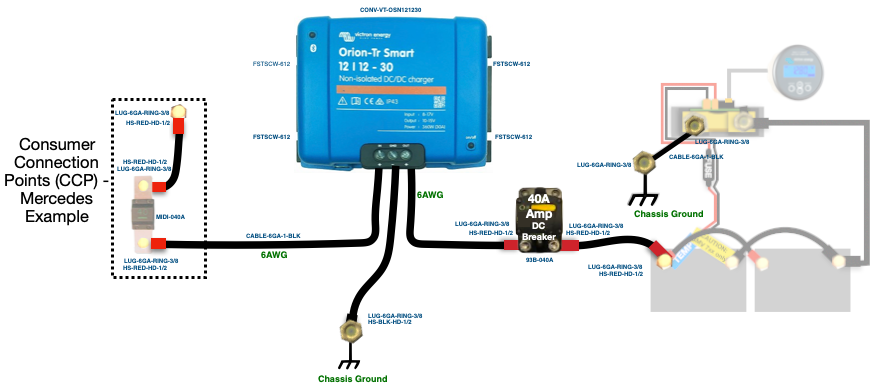



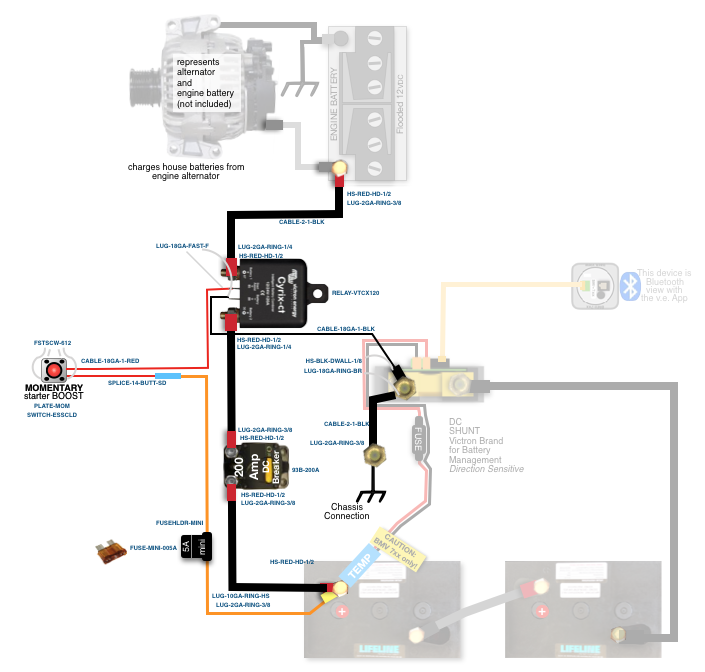

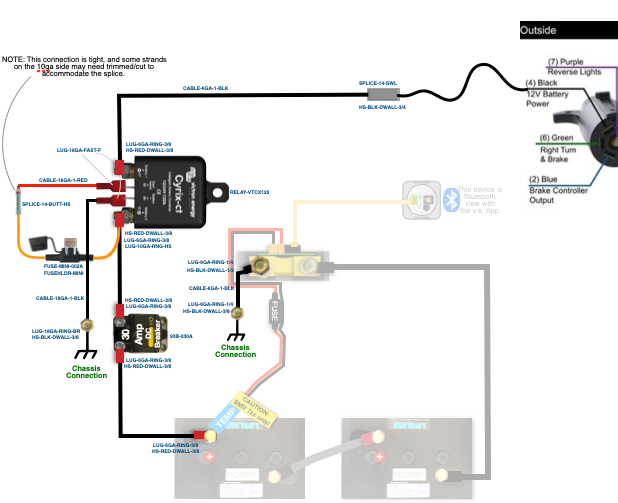

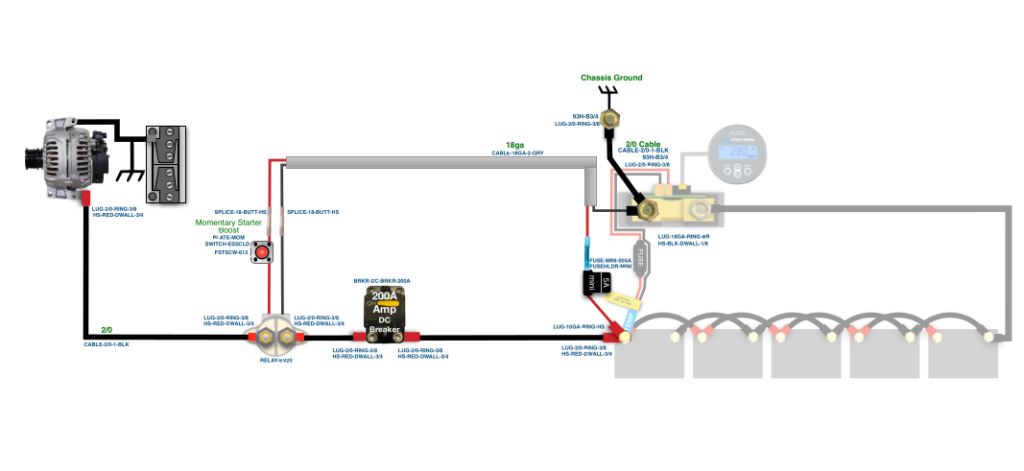
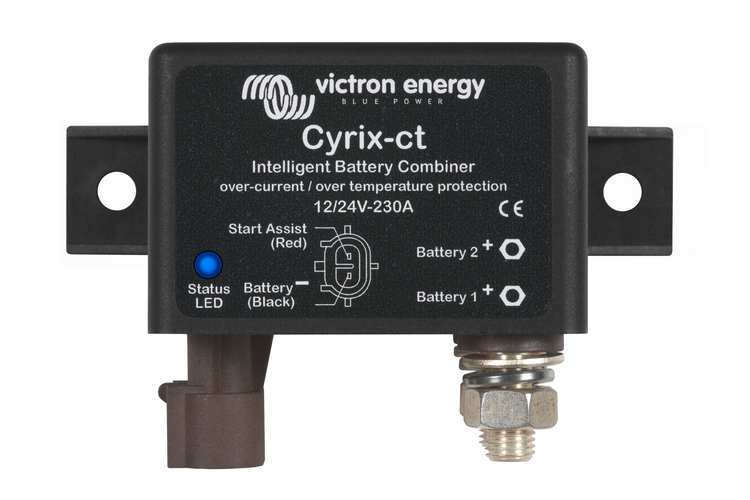
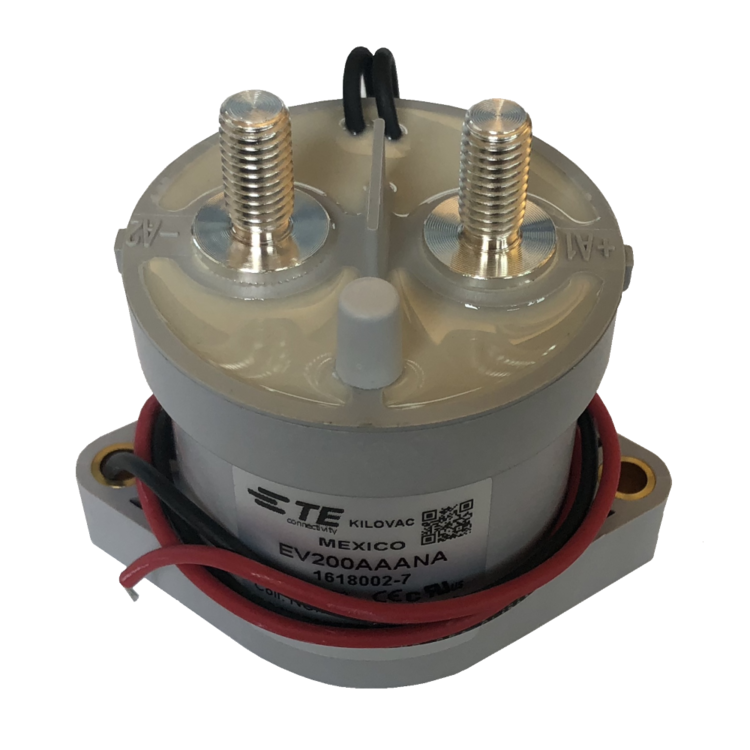
Temperature Sensor for BMV-712
Support from AMSolar is definitely 5 stars. 1st line of support for Victron equipment provided through distributors. AMSolar likely one of the best when it comes to RVs.
Tom B